Project & Quality Management: System Development for Bendigo Tours
VerifiedAdded on 2023/04/21
|19
|3490
|181
Project
AI Summary
This project plan outlines the development of an information system for Bendigo Tours & Travel, a leading Australian travel agency. The system aims to support the company's operations, facilitate future growth, and cater to both internal business needs and customer requests. Key deliverables include a fully functional information system with 24/7 customer support, user documentation, staff training, and maintenance documentation. The project is estimated to take 7 months with an initial cost of $680,000. The plan includes a stakeholder register and management strategy, a team contract, a financial analysis demonstrating a positive NPV, and the selection of the Agile SDLC model for its adaptability and customer focus. A work breakdown structure (WBS), Gantt chart, and critical path method (CPM) analysis are provided to manage project timelines and resources effectively. The plan also addresses schedule trade-offs, float of activities, communication management, risk identification, and weekly status reporting to ensure successful project execution. The document is available on Desklib, a platform offering study tools and solved assignments for students.
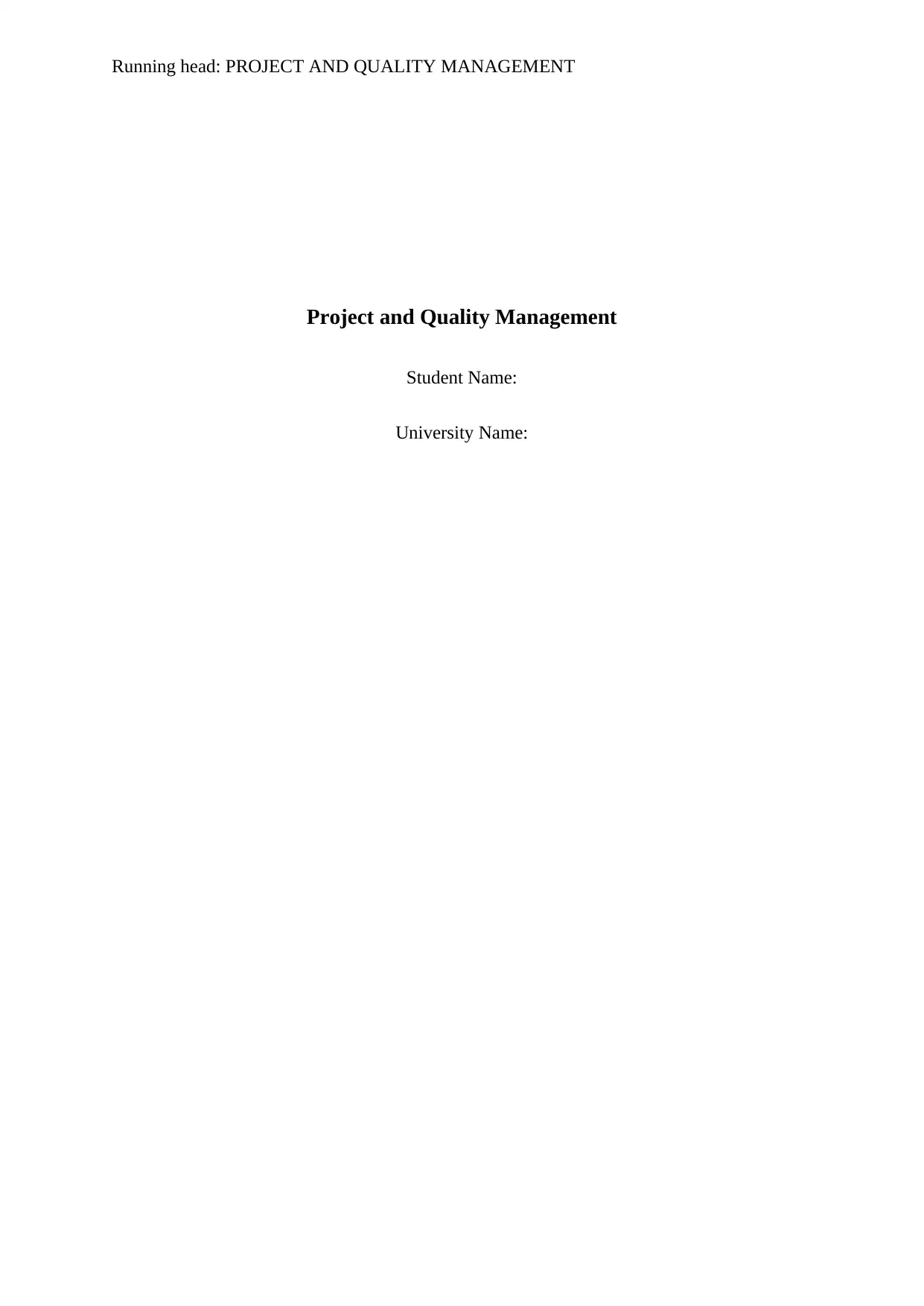
Running head: PROJECT AND QUALITY MANAGEMENT
Project and Quality Management
Student Name:
University Name:
Project and Quality Management
Student Name:
University Name:
Paraphrase This Document
Need a fresh take? Get an instant paraphrase of this document with our AI Paraphraser
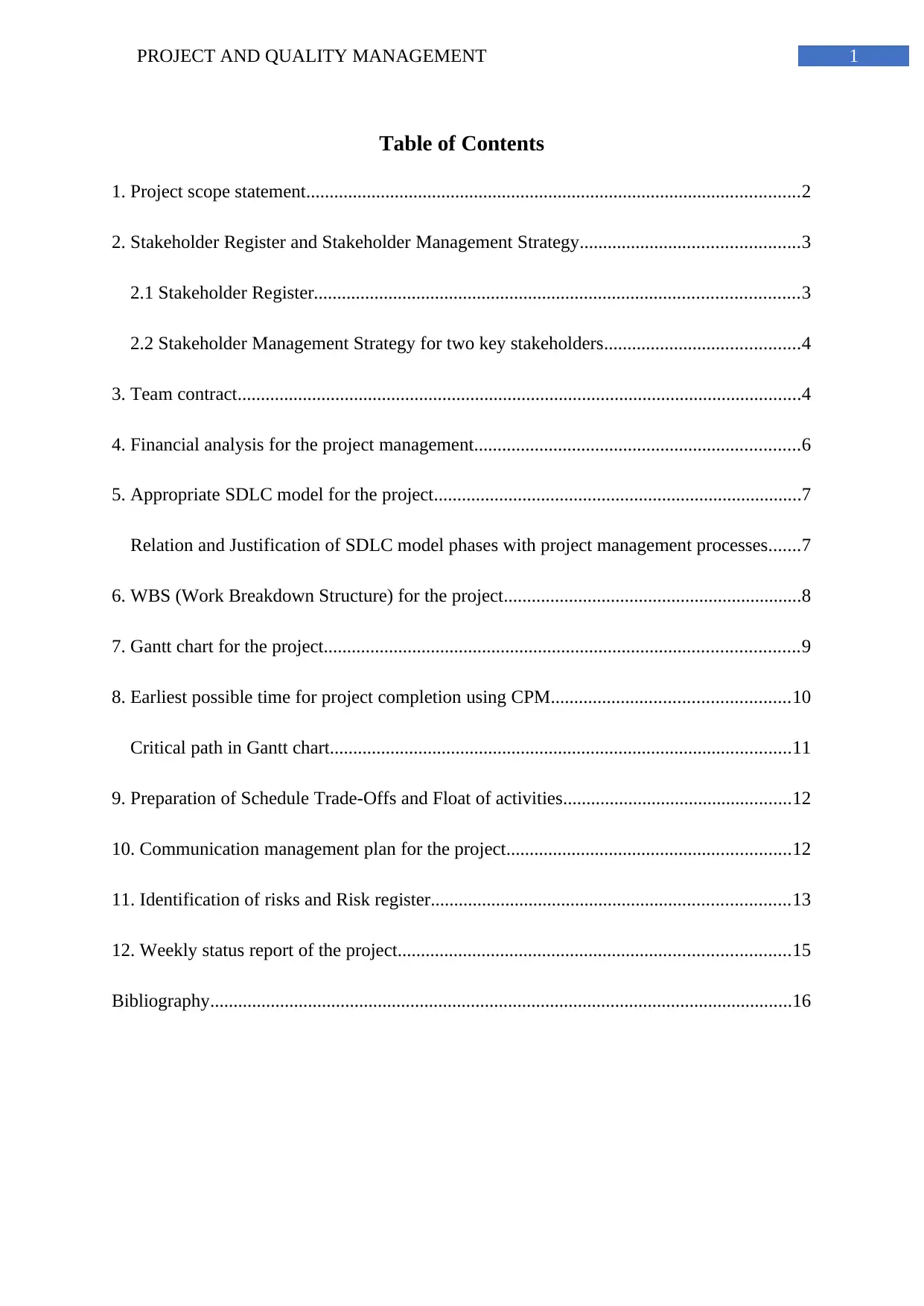
1PROJECT AND QUALITY MANAGEMENT
Table of Contents
1. Project scope statement..........................................................................................................2
2. Stakeholder Register and Stakeholder Management Strategy...............................................3
2.1 Stakeholder Register........................................................................................................3
2.2 Stakeholder Management Strategy for two key stakeholders..........................................4
3. Team contract.........................................................................................................................4
4. Financial analysis for the project management......................................................................6
5. Appropriate SDLC model for the project...............................................................................7
Relation and Justification of SDLC model phases with project management processes.......7
6. WBS (Work Breakdown Structure) for the project................................................................8
7. Gantt chart for the project......................................................................................................9
8. Earliest possible time for project completion using CPM...................................................10
Critical path in Gantt chart...................................................................................................11
9. Preparation of Schedule Trade-Offs and Float of activities.................................................12
10. Communication management plan for the project.............................................................12
11. Identification of risks and Risk register.............................................................................13
12. Weekly status report of the project....................................................................................15
Bibliography.............................................................................................................................16
Table of Contents
1. Project scope statement..........................................................................................................2
2. Stakeholder Register and Stakeholder Management Strategy...............................................3
2.1 Stakeholder Register........................................................................................................3
2.2 Stakeholder Management Strategy for two key stakeholders..........................................4
3. Team contract.........................................................................................................................4
4. Financial analysis for the project management......................................................................6
5. Appropriate SDLC model for the project...............................................................................7
Relation and Justification of SDLC model phases with project management processes.......7
6. WBS (Work Breakdown Structure) for the project................................................................8
7. Gantt chart for the project......................................................................................................9
8. Earliest possible time for project completion using CPM...................................................10
Critical path in Gantt chart...................................................................................................11
9. Preparation of Schedule Trade-Offs and Float of activities.................................................12
10. Communication management plan for the project.............................................................12
11. Identification of risks and Risk register.............................................................................13
12. Weekly status report of the project....................................................................................15
Bibliography.............................................................................................................................16
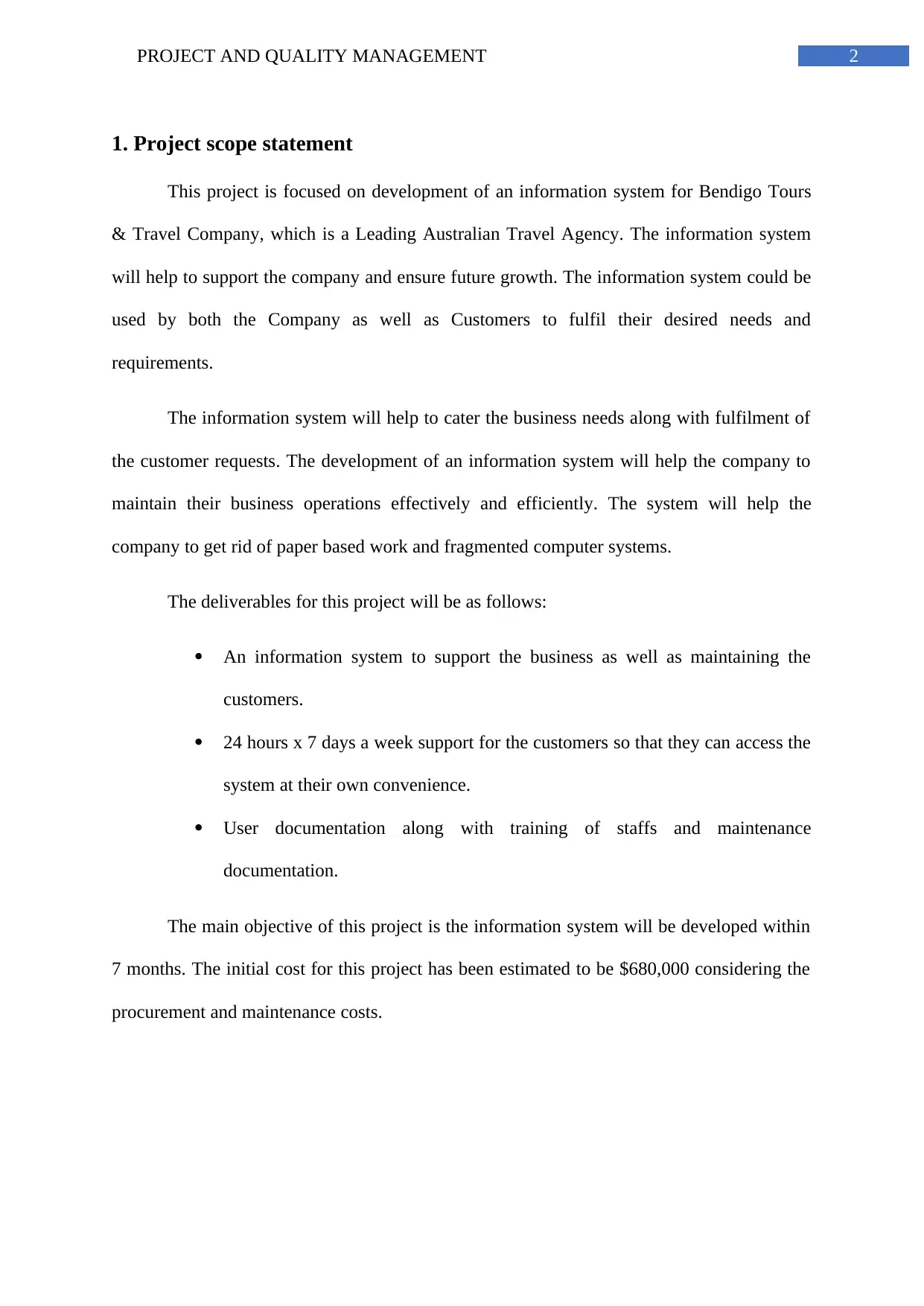
2PROJECT AND QUALITY MANAGEMENT
1. Project scope statement
This project is focused on development of an information system for Bendigo Tours
& Travel Company, which is a Leading Australian Travel Agency. The information system
will help to support the company and ensure future growth. The information system could be
used by both the Company as well as Customers to fulfil their desired needs and
requirements.
The information system will help to cater the business needs along with fulfilment of
the customer requests. The development of an information system will help the company to
maintain their business operations effectively and efficiently. The system will help the
company to get rid of paper based work and fragmented computer systems.
The deliverables for this project will be as follows:
An information system to support the business as well as maintaining the
customers.
24 hours x 7 days a week support for the customers so that they can access the
system at their own convenience.
User documentation along with training of staffs and maintenance
documentation.
The main objective of this project is the information system will be developed within
7 months. The initial cost for this project has been estimated to be $680,000 considering the
procurement and maintenance costs.
1. Project scope statement
This project is focused on development of an information system for Bendigo Tours
& Travel Company, which is a Leading Australian Travel Agency. The information system
will help to support the company and ensure future growth. The information system could be
used by both the Company as well as Customers to fulfil their desired needs and
requirements.
The information system will help to cater the business needs along with fulfilment of
the customer requests. The development of an information system will help the company to
maintain their business operations effectively and efficiently. The system will help the
company to get rid of paper based work and fragmented computer systems.
The deliverables for this project will be as follows:
An information system to support the business as well as maintaining the
customers.
24 hours x 7 days a week support for the customers so that they can access the
system at their own convenience.
User documentation along with training of staffs and maintenance
documentation.
The main objective of this project is the information system will be developed within
7 months. The initial cost for this project has been estimated to be $680,000 considering the
procurement and maintenance costs.
⊘ This is a preview!⊘
Do you want full access?
Subscribe today to unlock all pages.

Trusted by 1+ million students worldwide
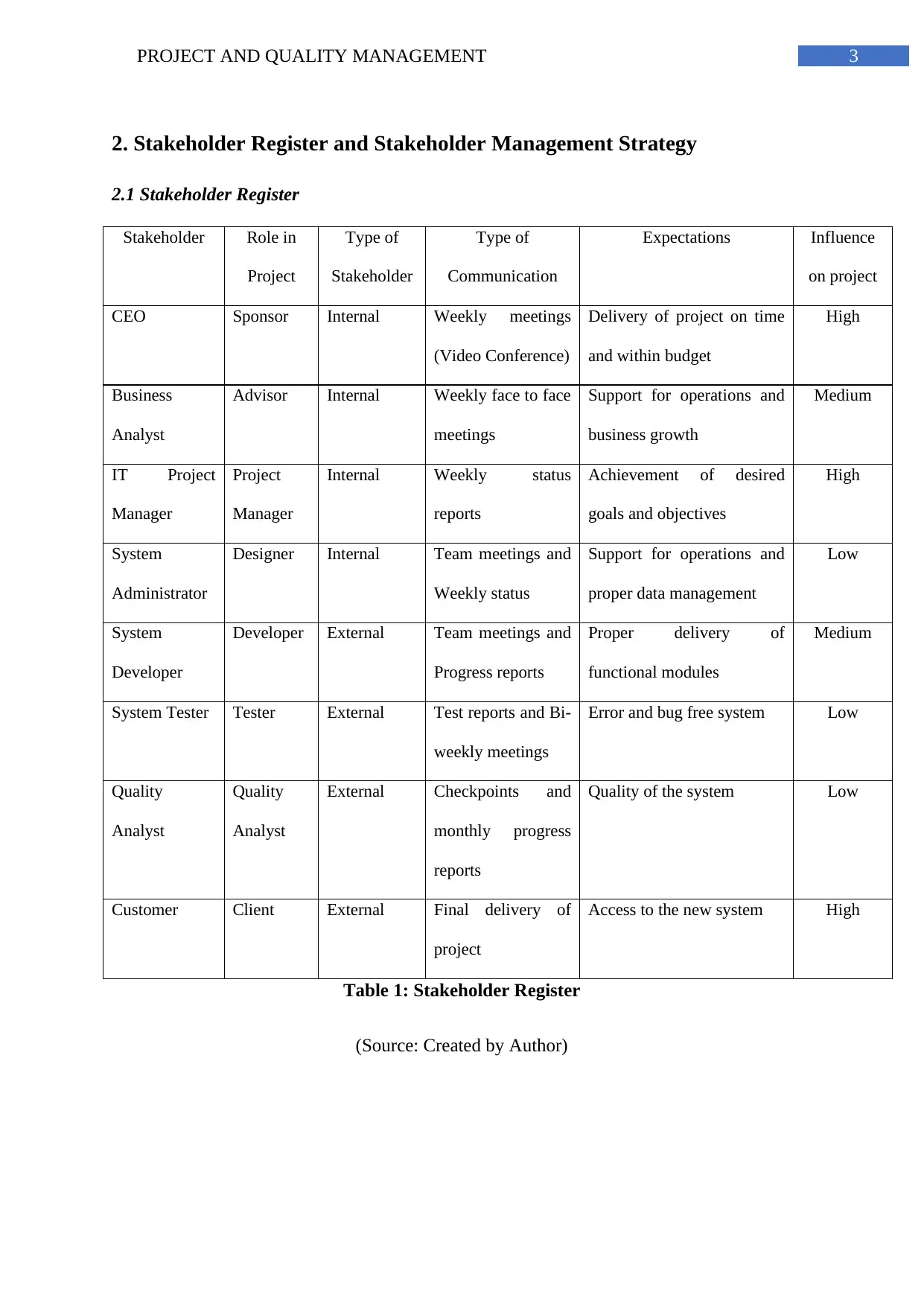
3PROJECT AND QUALITY MANAGEMENT
2. Stakeholder Register and Stakeholder Management Strategy
2.1 Stakeholder Register
Stakeholder Role in
Project
Type of
Stakeholder
Type of
Communication
Expectations Influence
on project
CEO Sponsor Internal Weekly meetings
(Video Conference)
Delivery of project on time
and within budget
High
Business
Analyst
Advisor Internal Weekly face to face
meetings
Support for operations and
business growth
Medium
IT Project
Manager
Project
Manager
Internal Weekly status
reports
Achievement of desired
goals and objectives
High
System
Administrator
Designer Internal Team meetings and
Weekly status
Support for operations and
proper data management
Low
System
Developer
Developer External Team meetings and
Progress reports
Proper delivery of
functional modules
Medium
System Tester Tester External Test reports and Bi-
weekly meetings
Error and bug free system Low
Quality
Analyst
Quality
Analyst
External Checkpoints and
monthly progress
reports
Quality of the system Low
Customer Client External Final delivery of
project
Access to the new system High
Table 1: Stakeholder Register
(Source: Created by Author)
2. Stakeholder Register and Stakeholder Management Strategy
2.1 Stakeholder Register
Stakeholder Role in
Project
Type of
Stakeholder
Type of
Communication
Expectations Influence
on project
CEO Sponsor Internal Weekly meetings
(Video Conference)
Delivery of project on time
and within budget
High
Business
Analyst
Advisor Internal Weekly face to face
meetings
Support for operations and
business growth
Medium
IT Project
Manager
Project
Manager
Internal Weekly status
reports
Achievement of desired
goals and objectives
High
System
Administrator
Designer Internal Team meetings and
Weekly status
Support for operations and
proper data management
Low
System
Developer
Developer External Team meetings and
Progress reports
Proper delivery of
functional modules
Medium
System Tester Tester External Test reports and Bi-
weekly meetings
Error and bug free system Low
Quality
Analyst
Quality
Analyst
External Checkpoints and
monthly progress
reports
Quality of the system Low
Customer Client External Final delivery of
project
Access to the new system High
Table 1: Stakeholder Register
(Source: Created by Author)
Paraphrase This Document
Need a fresh take? Get an instant paraphrase of this document with our AI Paraphraser
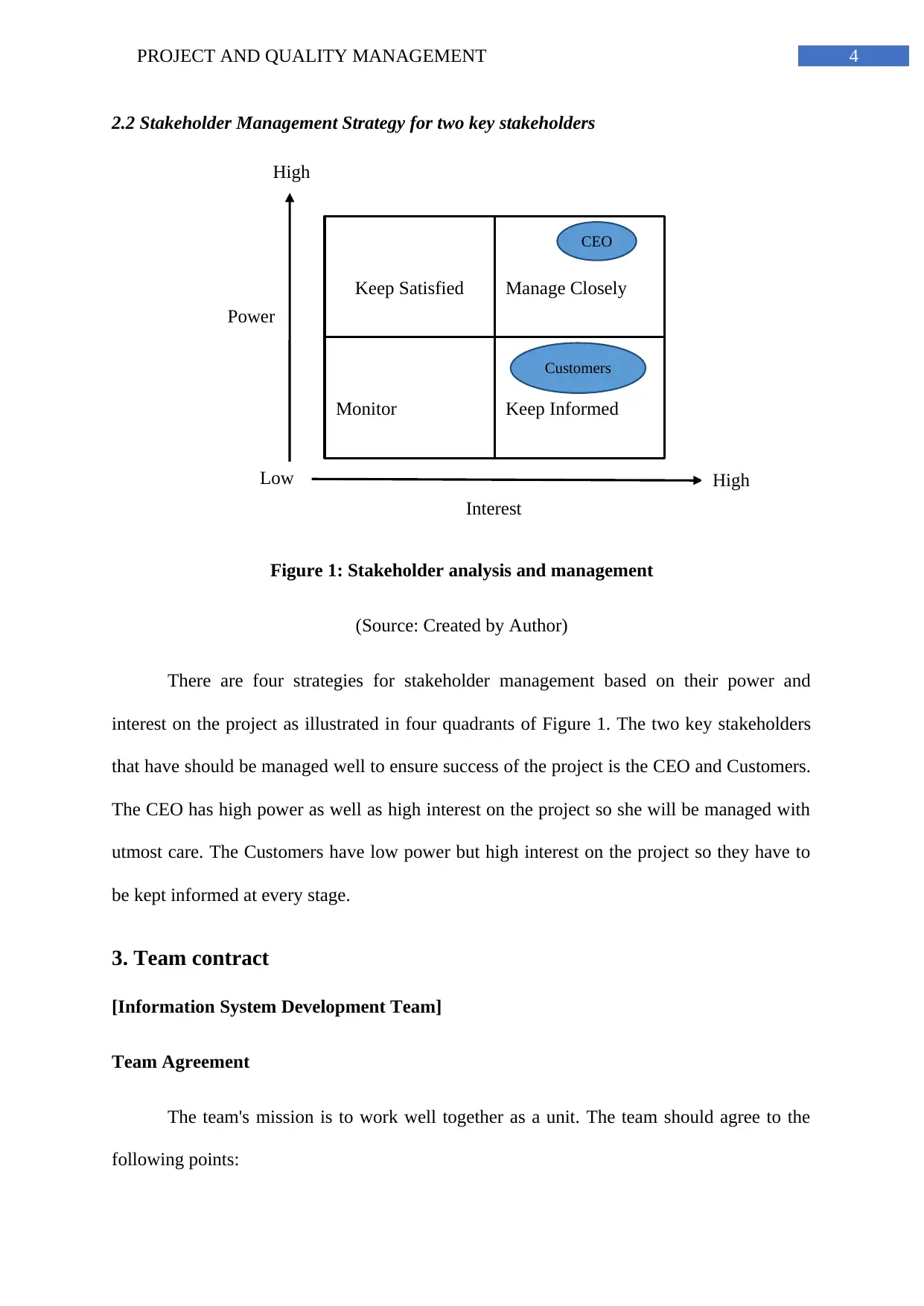
4PROJECT AND QUALITY MANAGEMENT
Power
Interest
Keep Satisfied Manage Closely
Monitor Keep Informed
Low
High
High
CEO
Customers
2.2 Stakeholder Management Strategy for two key stakeholders
Figure 1: Stakeholder analysis and management
(Source: Created by Author)
There are four strategies for stakeholder management based on their power and
interest on the project as illustrated in four quadrants of Figure 1. The two key stakeholders
that have should be managed well to ensure success of the project is the CEO and Customers.
The CEO has high power as well as high interest on the project so she will be managed with
utmost care. The Customers have low power but high interest on the project so they have to
be kept informed at every stage.
3. Team contract
[Information System Development Team]
Team Agreement
The team's mission is to work well together as a unit. The team should agree to the
following points:
Power
Interest
Keep Satisfied Manage Closely
Monitor Keep Informed
Low
High
High
CEO
Customers
2.2 Stakeholder Management Strategy for two key stakeholders
Figure 1: Stakeholder analysis and management
(Source: Created by Author)
There are four strategies for stakeholder management based on their power and
interest on the project as illustrated in four quadrants of Figure 1. The two key stakeholders
that have should be managed well to ensure success of the project is the CEO and Customers.
The CEO has high power as well as high interest on the project so she will be managed with
utmost care. The Customers have low power but high interest on the project so they have to
be kept informed at every stage.
3. Team contract
[Information System Development Team]
Team Agreement
The team's mission is to work well together as a unit. The team should agree to the
following points:
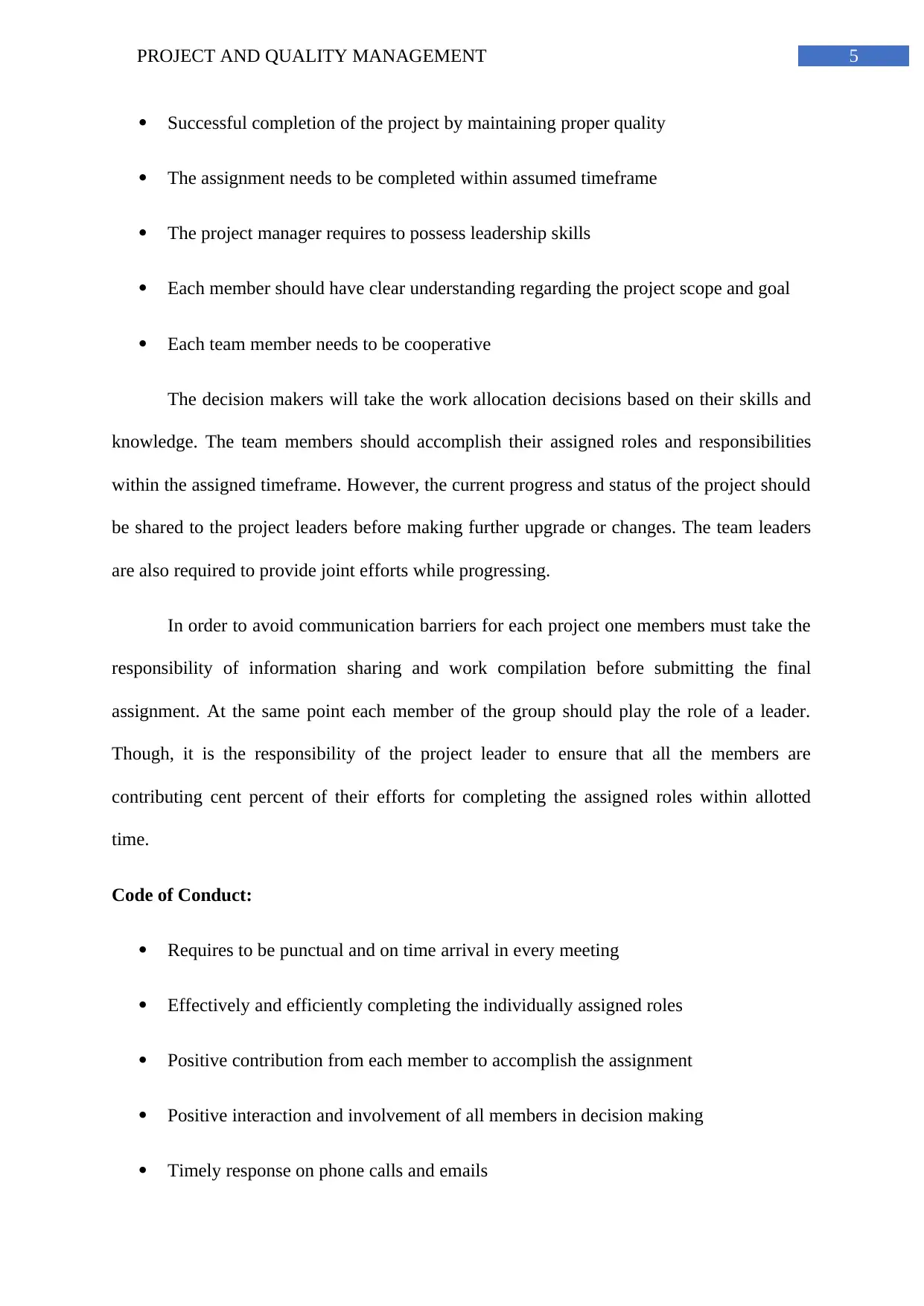
5PROJECT AND QUALITY MANAGEMENT
Successful completion of the project by maintaining proper quality
The assignment needs to be completed within assumed timeframe
The project manager requires to possess leadership skills
Each member should have clear understanding regarding the project scope and goal
Each team member needs to be cooperative
The decision makers will take the work allocation decisions based on their skills and
knowledge. The team members should accomplish their assigned roles and responsibilities
within the assigned timeframe. However, the current progress and status of the project should
be shared to the project leaders before making further upgrade or changes. The team leaders
are also required to provide joint efforts while progressing.
In order to avoid communication barriers for each project one members must take the
responsibility of information sharing and work compilation before submitting the final
assignment. At the same point each member of the group should play the role of a leader.
Though, it is the responsibility of the project leader to ensure that all the members are
contributing cent percent of their efforts for completing the assigned roles within allotted
time.
Code of Conduct:
Requires to be punctual and on time arrival in every meeting
Effectively and efficiently completing the individually assigned roles
Positive contribution from each member to accomplish the assignment
Positive interaction and involvement of all members in decision making
Timely response on phone calls and emails
Successful completion of the project by maintaining proper quality
The assignment needs to be completed within assumed timeframe
The project manager requires to possess leadership skills
Each member should have clear understanding regarding the project scope and goal
Each team member needs to be cooperative
The decision makers will take the work allocation decisions based on their skills and
knowledge. The team members should accomplish their assigned roles and responsibilities
within the assigned timeframe. However, the current progress and status of the project should
be shared to the project leaders before making further upgrade or changes. The team leaders
are also required to provide joint efforts while progressing.
In order to avoid communication barriers for each project one members must take the
responsibility of information sharing and work compilation before submitting the final
assignment. At the same point each member of the group should play the role of a leader.
Though, it is the responsibility of the project leader to ensure that all the members are
contributing cent percent of their efforts for completing the assigned roles within allotted
time.
Code of Conduct:
Requires to be punctual and on time arrival in every meeting
Effectively and efficiently completing the individually assigned roles
Positive contribution from each member to accomplish the assignment
Positive interaction and involvement of all members in decision making
Timely response on phone calls and emails
⊘ This is a preview!⊘
Do you want full access?
Subscribe today to unlock all pages.

Trusted by 1+ million students worldwide
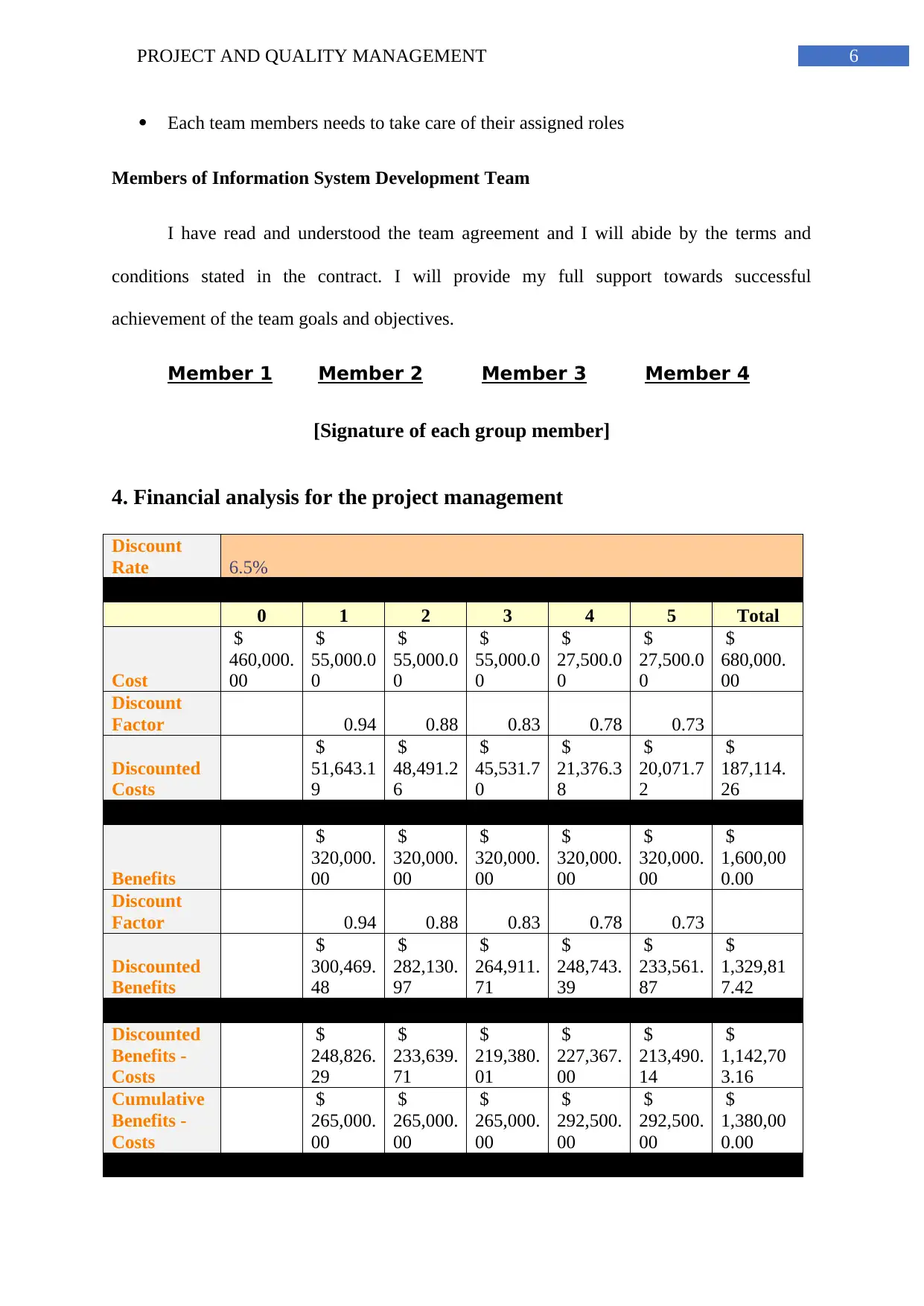
6PROJECT AND QUALITY MANAGEMENT
Each team members needs to take care of their assigned roles
Members of Information System Development Team
I have read and understood the team agreement and I will abide by the terms and
conditions stated in the contract. I will provide my full support towards successful
achievement of the team goals and objectives.
Member 1 Member 2 Member 3 Member 4
[Signature of each group member]
4. Financial analysis for the project management
Discount
Rate 6.5%
0 1 2 3 4 5 Total
Cost
$
460,000.
00
$
55,000.0
0
$
55,000.0
0
$
55,000.0
0
$
27,500.0
0
$
27,500.0
0
$
680,000.
00
Discount
Factor 0.94 0.88 0.83 0.78 0.73
Discounted
Costs
$
51,643.1
9
$
48,491.2
6
$
45,531.7
0
$
21,376.3
8
$
20,071.7
2
$
187,114.
26
Benefits
$
320,000.
00
$
320,000.
00
$
320,000.
00
$
320,000.
00
$
320,000.
00
$
1,600,00
0.00
Discount
Factor 0.94 0.88 0.83 0.78 0.73
Discounted
Benefits
$
300,469.
48
$
282,130.
97
$
264,911.
71
$
248,743.
39
$
233,561.
87
$
1,329,81
7.42
Discounted
Benefits -
Costs
$
248,826.
29
$
233,639.
71
$
219,380.
01
$
227,367.
00
$
213,490.
14
$
1,142,70
3.16
Cumulative
Benefits -
Costs
$
265,000.
00
$
265,000.
00
$
265,000.
00
$
292,500.
00
$
292,500.
00
$
1,380,00
0.00
Each team members needs to take care of their assigned roles
Members of Information System Development Team
I have read and understood the team agreement and I will abide by the terms and
conditions stated in the contract. I will provide my full support towards successful
achievement of the team goals and objectives.
Member 1 Member 2 Member 3 Member 4
[Signature of each group member]
4. Financial analysis for the project management
Discount
Rate 6.5%
0 1 2 3 4 5 Total
Cost
$
460,000.
00
$
55,000.0
0
$
55,000.0
0
$
55,000.0
0
$
27,500.0
0
$
27,500.0
0
$
680,000.
00
Discount
Factor 0.94 0.88 0.83 0.78 0.73
Discounted
Costs
$
51,643.1
9
$
48,491.2
6
$
45,531.7
0
$
21,376.3
8
$
20,071.7
2
$
187,114.
26
Benefits
$
320,000.
00
$
320,000.
00
$
320,000.
00
$
320,000.
00
$
320,000.
00
$
1,600,00
0.00
Discount
Factor 0.94 0.88 0.83 0.78 0.73
Discounted
Benefits
$
300,469.
48
$
282,130.
97
$
264,911.
71
$
248,743.
39
$
233,561.
87
$
1,329,81
7.42
Discounted
Benefits -
Costs
$
248,826.
29
$
233,639.
71
$
219,380.
01
$
227,367.
00
$
213,490.
14
$
1,142,70
3.16
Cumulative
Benefits -
Costs
$
265,000.
00
$
265,000.
00
$
265,000.
00
$
292,500.
00
$
292,500.
00
$
1,380,00
0.00
Paraphrase This Document
Need a fresh take? Get an instant paraphrase of this document with our AI Paraphraser
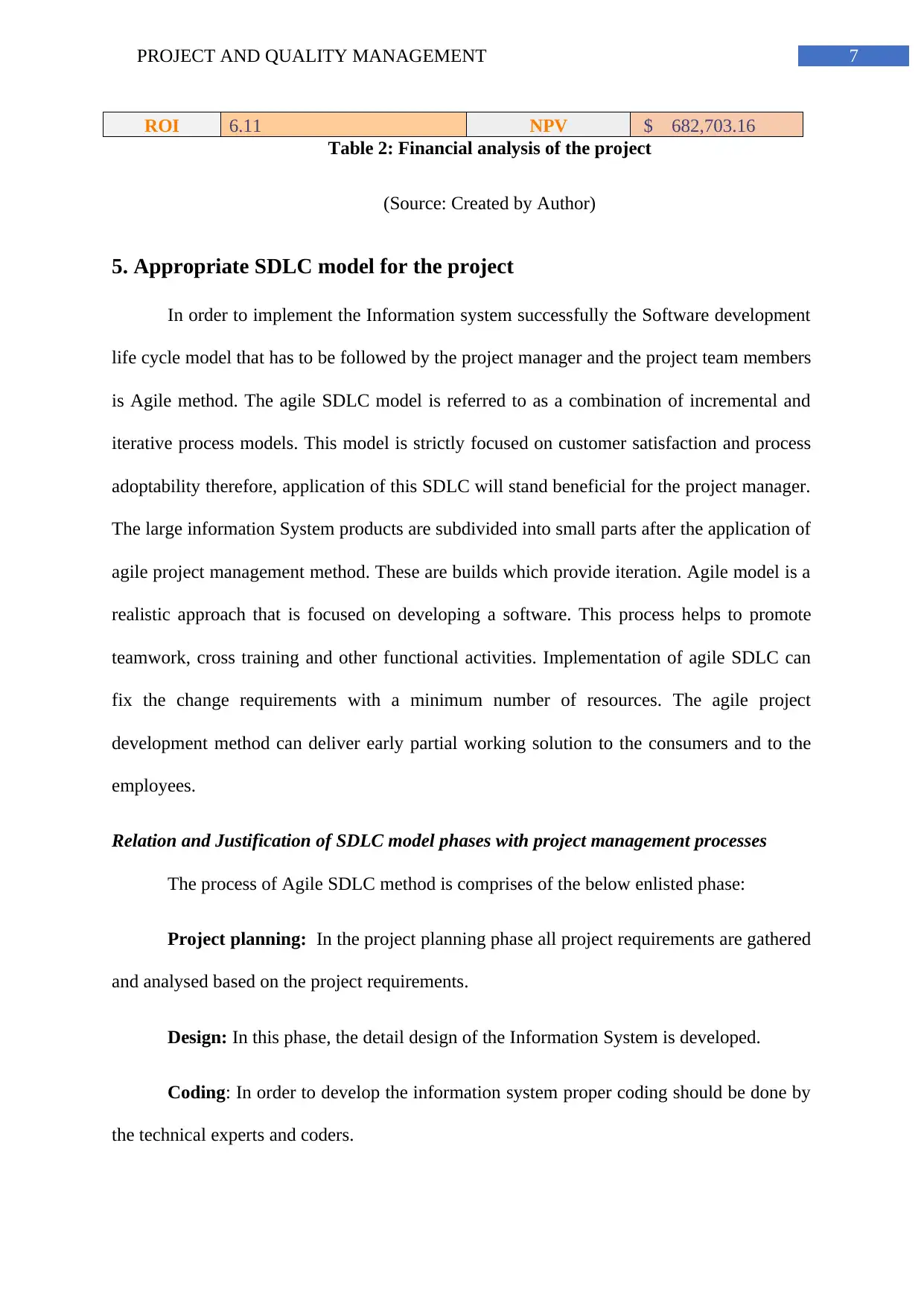
7PROJECT AND QUALITY MANAGEMENT
ROI 6.11 NPV $ 682,703.16
Table 2: Financial analysis of the project
(Source: Created by Author)
5. Appropriate SDLC model for the project
In order to implement the Information system successfully the Software development
life cycle model that has to be followed by the project manager and the project team members
is Agile method. The agile SDLC model is referred to as a combination of incremental and
iterative process models. This model is strictly focused on customer satisfaction and process
adoptability therefore, application of this SDLC will stand beneficial for the project manager.
The large information System products are subdivided into small parts after the application of
agile project management method. These are builds which provide iteration. Agile model is a
realistic approach that is focused on developing a software. This process helps to promote
teamwork, cross training and other functional activities. Implementation of agile SDLC can
fix the change requirements with a minimum number of resources. The agile project
development method can deliver early partial working solution to the consumers and to the
employees.
Relation and Justification of SDLC model phases with project management processes
The process of Agile SDLC method is comprises of the below enlisted phase:
Project planning: In the project planning phase all project requirements are gathered
and analysed based on the project requirements.
Design: In this phase, the detail design of the Information System is developed.
Coding: In order to develop the information system proper coding should be done by
the technical experts and coders.
ROI 6.11 NPV $ 682,703.16
Table 2: Financial analysis of the project
(Source: Created by Author)
5. Appropriate SDLC model for the project
In order to implement the Information system successfully the Software development
life cycle model that has to be followed by the project manager and the project team members
is Agile method. The agile SDLC model is referred to as a combination of incremental and
iterative process models. This model is strictly focused on customer satisfaction and process
adoptability therefore, application of this SDLC will stand beneficial for the project manager.
The large information System products are subdivided into small parts after the application of
agile project management method. These are builds which provide iteration. Agile model is a
realistic approach that is focused on developing a software. This process helps to promote
teamwork, cross training and other functional activities. Implementation of agile SDLC can
fix the change requirements with a minimum number of resources. The agile project
development method can deliver early partial working solution to the consumers and to the
employees.
Relation and Justification of SDLC model phases with project management processes
The process of Agile SDLC method is comprises of the below enlisted phase:
Project planning: In the project planning phase all project requirements are gathered
and analysed based on the project requirements.
Design: In this phase, the detail design of the Information System is developed.
Coding: In order to develop the information system proper coding should be done by
the technical experts and coders.
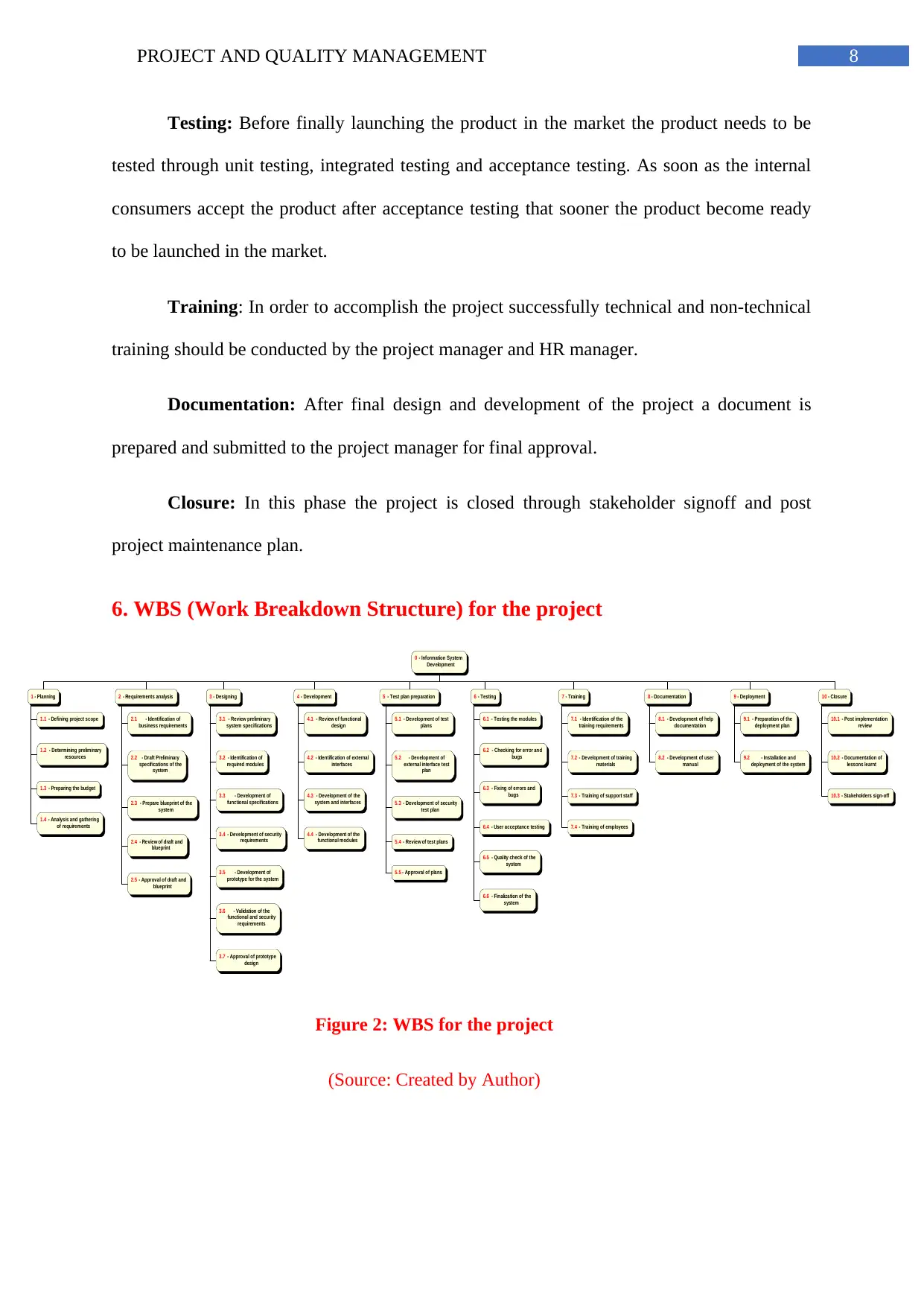
8PROJECT AND QUALITY MANAGEMENT
Testing: Before finally launching the product in the market the product needs to be
tested through unit testing, integrated testing and acceptance testing. As soon as the internal
consumers accept the product after acceptance testing that sooner the product become ready
to be launched in the market.
Training: In order to accomplish the project successfully technical and non-technical
training should be conducted by the project manager and HR manager.
Documentation: After final design and development of the project a document is
prepared and submitted to the project manager for final approval.
Closure: In this phase the project is closed through stakeholder signoff and post
project maintenance plan.
6. WBS (Work Breakdown Structure) for the project
0 - Information System
Development
1 - Planning
1.1 - Defining project scope
1.2 - Determining preliminary
resources
1.3 - Preparing the budget
1.4 - Analysis and gathering
of requirements
2 - Requirements analysis
2.1 - Identification of
business requirements
2.2 - Draft Preliminary
specifications of the
system
2.3 - Prepare blueprint of the
system
2.4 - Review of draft and
blueprint
2.5 - Approval of draft and
blueprint
3 - Designing
3.1 - Review preliminary
system specifications
3.2 - Identification of
required modules
3.3 - Development of
functional specifications
3.4 - Development of security
requirements
3.5 - Development of
prototype for the system
3.6 - Validation of the
functional and security
requirements
3.7 - Approval of prototype
design
4 - Development
4.1 - Review of functional
design
4.2 - Identification of external
interfaces
4.3 - Development of the
system and interfaces
4.4 - Development of the
functional modules
5 - Test plan preparation
5.1 - Development of test
plans
5.2 - Development of
external interface test
plan
5.3 - Development of security
test plan
5.4 - Review of test plans
5.5 - Approval of plans
6 - Testing
6.1 - Testing the modules
6.2 - Checking for error and
bugs
6.3 - Fixing of errors and
bugs
6.4 - User acceptance testing
6.5 - Quality check of the
system
6.6 - Finalization of the
system
7 - Training
7.1 - Identification of the
training requirements
7.2 - Development of training
materials
7.3 - Training of support staff
7.4 - Training of employees
8 - Documentation
8.1 - Development of help
documentation
8.2 - Development of user
manual
9 - Deployment
9.1 - Preparation of the
deployment plan
9.2 - Installation and
deployment of the system
10 - Closure
10.1 - Post implementation
review
10.2 - Documentation of
lessons learnt
10.3 - Stakeholders sign-off
Figure 2: WBS for the project
(Source: Created by Author)
Testing: Before finally launching the product in the market the product needs to be
tested through unit testing, integrated testing and acceptance testing. As soon as the internal
consumers accept the product after acceptance testing that sooner the product become ready
to be launched in the market.
Training: In order to accomplish the project successfully technical and non-technical
training should be conducted by the project manager and HR manager.
Documentation: After final design and development of the project a document is
prepared and submitted to the project manager for final approval.
Closure: In this phase the project is closed through stakeholder signoff and post
project maintenance plan.
6. WBS (Work Breakdown Structure) for the project
0 - Information System
Development
1 - Planning
1.1 - Defining project scope
1.2 - Determining preliminary
resources
1.3 - Preparing the budget
1.4 - Analysis and gathering
of requirements
2 - Requirements analysis
2.1 - Identification of
business requirements
2.2 - Draft Preliminary
specifications of the
system
2.3 - Prepare blueprint of the
system
2.4 - Review of draft and
blueprint
2.5 - Approval of draft and
blueprint
3 - Designing
3.1 - Review preliminary
system specifications
3.2 - Identification of
required modules
3.3 - Development of
functional specifications
3.4 - Development of security
requirements
3.5 - Development of
prototype for the system
3.6 - Validation of the
functional and security
requirements
3.7 - Approval of prototype
design
4 - Development
4.1 - Review of functional
design
4.2 - Identification of external
interfaces
4.3 - Development of the
system and interfaces
4.4 - Development of the
functional modules
5 - Test plan preparation
5.1 - Development of test
plans
5.2 - Development of
external interface test
plan
5.3 - Development of security
test plan
5.4 - Review of test plans
5.5 - Approval of plans
6 - Testing
6.1 - Testing the modules
6.2 - Checking for error and
bugs
6.3 - Fixing of errors and
bugs
6.4 - User acceptance testing
6.5 - Quality check of the
system
6.6 - Finalization of the
system
7 - Training
7.1 - Identification of the
training requirements
7.2 - Development of training
materials
7.3 - Training of support staff
7.4 - Training of employees
8 - Documentation
8.1 - Development of help
documentation
8.2 - Development of user
manual
9 - Deployment
9.1 - Preparation of the
deployment plan
9.2 - Installation and
deployment of the system
10 - Closure
10.1 - Post implementation
review
10.2 - Documentation of
lessons learnt
10.3 - Stakeholders sign-off
Figure 2: WBS for the project
(Source: Created by Author)
⊘ This is a preview!⊘
Do you want full access?
Subscribe today to unlock all pages.

Trusted by 1+ million students worldwide
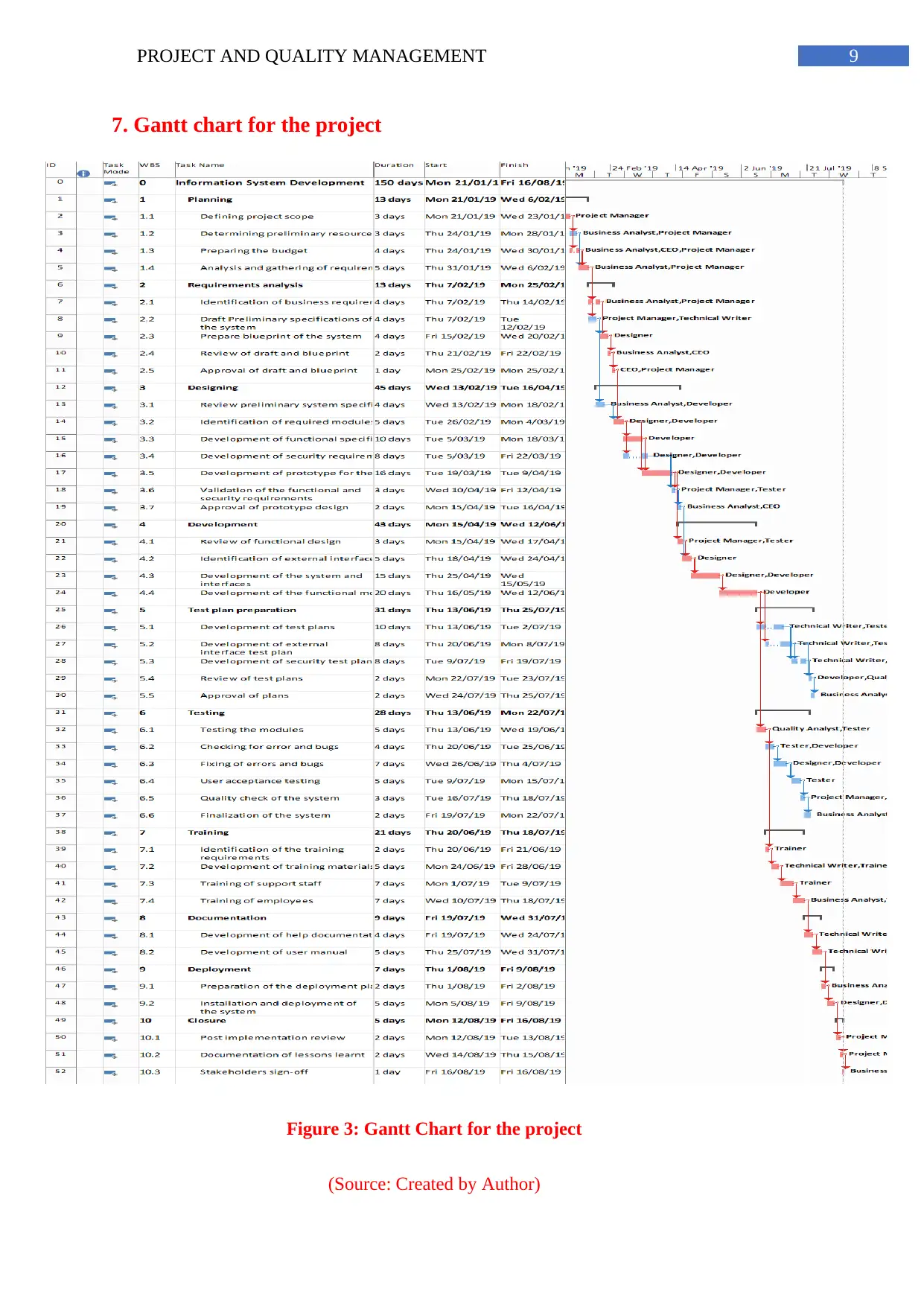
9PROJECT AND QUALITY MANAGEMENT
7. Gantt chart for the project
Figure 3: Gantt Chart for the project
(Source: Created by Author)
7. Gantt chart for the project
Figure 3: Gantt Chart for the project
(Source: Created by Author)
Paraphrase This Document
Need a fresh take? Get an instant paraphrase of this document with our AI Paraphraser
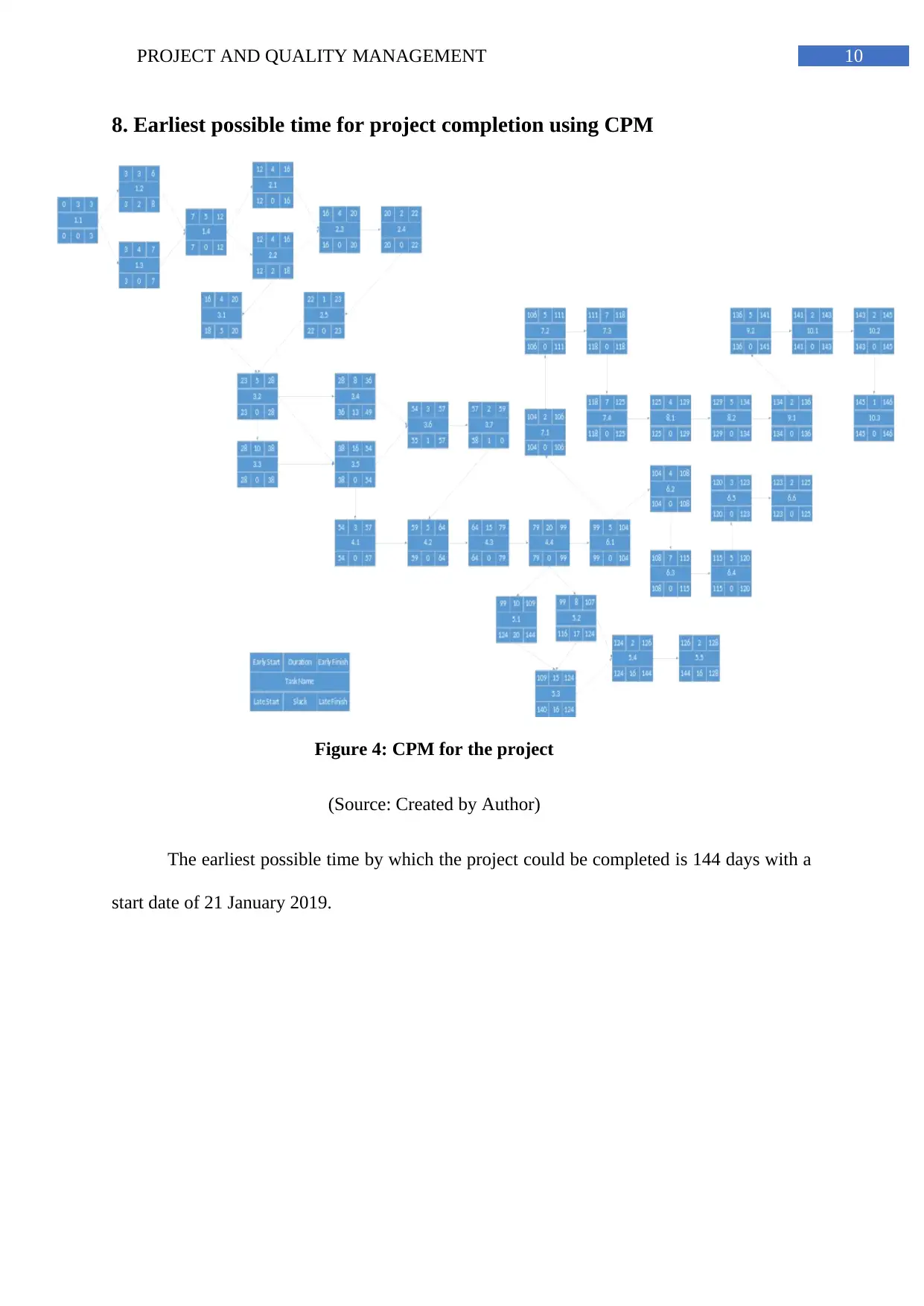
10PROJECT AND QUALITY MANAGEMENT
8. Earliest possible time for project completion using CPM
Figure 4: CPM for the project
(Source: Created by Author)
The earliest possible time by which the project could be completed is 144 days with a
start date of 21 January 2019.
8. Earliest possible time for project completion using CPM
Figure 4: CPM for the project
(Source: Created by Author)
The earliest possible time by which the project could be completed is 144 days with a
start date of 21 January 2019.
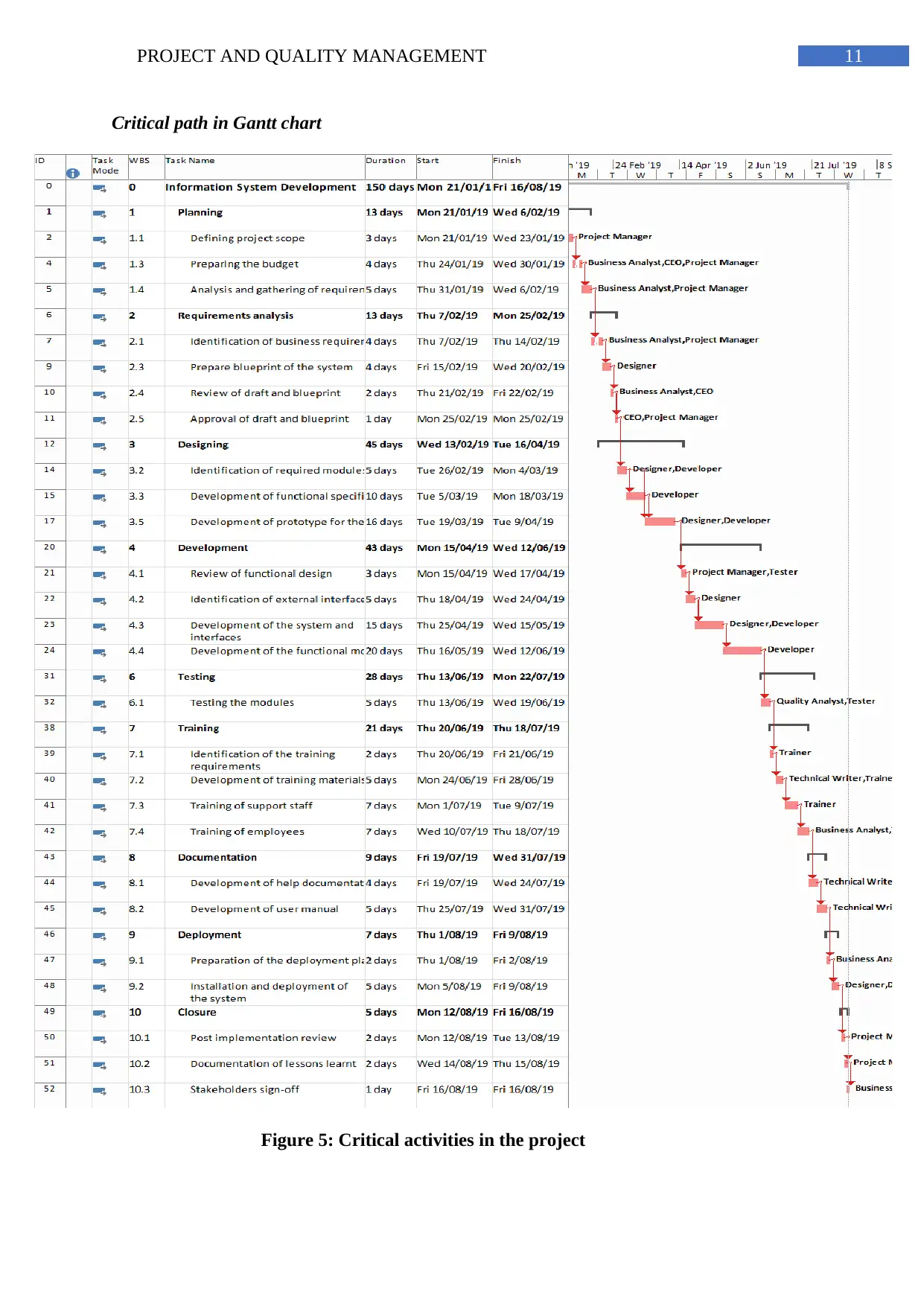
11PROJECT AND QUALITY MANAGEMENT
Critical path in Gantt chart
Figure 5: Critical activities in the project
Critical path in Gantt chart
Figure 5: Critical activities in the project
⊘ This is a preview!⊘
Do you want full access?
Subscribe today to unlock all pages.

Trusted by 1+ million students worldwide
1 out of 19
Related Documents
Your All-in-One AI-Powered Toolkit for Academic Success.
+13062052269
info@desklib.com
Available 24*7 on WhatsApp / Email
![[object Object]](/_next/static/media/star-bottom.7253800d.svg)
Unlock your academic potential
Copyright © 2020–2025 A2Z Services. All Rights Reserved. Developed and managed by ZUCOL.





